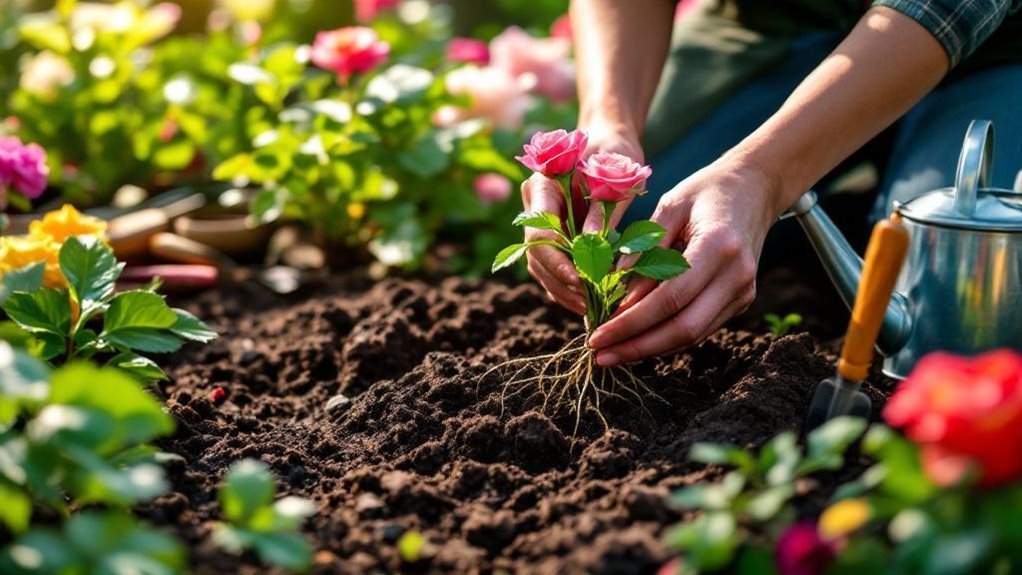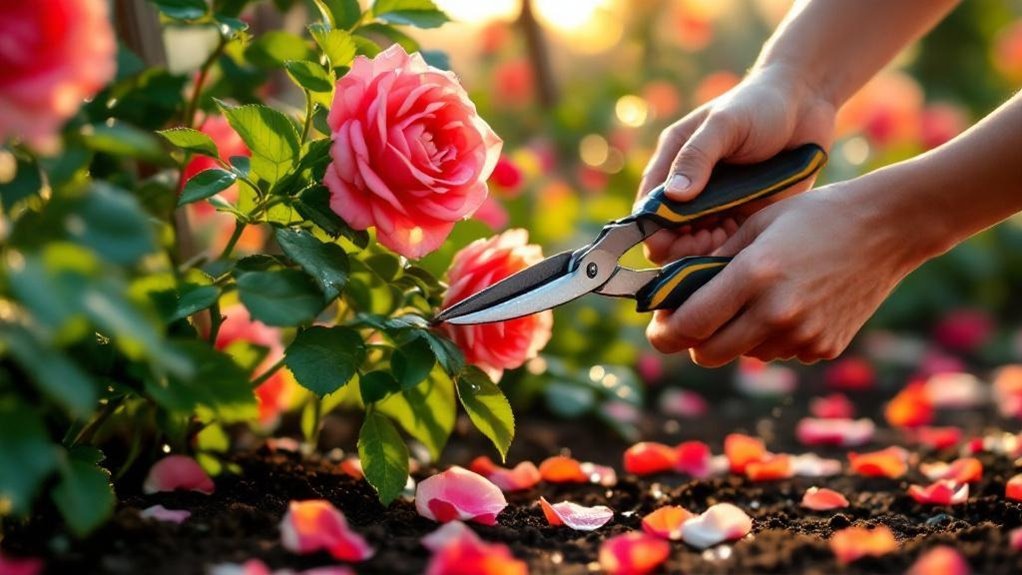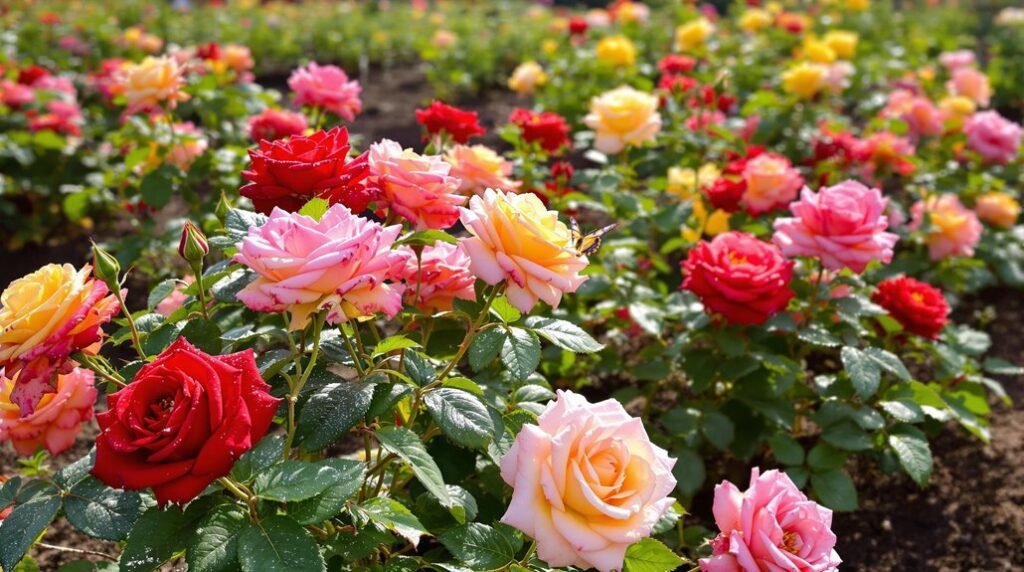Imagine stepping into your garden to find roses bursting with color and fragrance, their petals perfectly unfurling in the morning light. Growing roses isn’t just about planting a flower; it’s about nurturing a living work of art. But achieving those stunning blooms requires more than just luck—you’ll need to master the right varieties, site preparation, and care routines. Let’s explore what it takes to transform your rose-growing efforts into a consistent success.
Selecting the Right Rose Varieties
When selecting the right rose varieties, you’ll want to contemplate your garden’s unique conditions and your personal preferences.
Start by exploring the many Types of Roses available—from grandifloras and climbing roses to ground cover and micro-miniatures. Choosing well-chosen varieties like Knock Out shrub roses or Flower Carpet ground cover can provide continuous blooms and excellent disease resistance, perfect for low-maintenance landscapes.
Consider your soil type and sunlight exposure to guarantee ideal growth. Hybrid roses offer a range of colors and traits bred specifically for hardiness and disease resistance, making them great for your planting plans.
Limiting the number of rose bushes you grow helps maintain an organized garden that’s easier to care for, so pick varieties that suit your space and gardening style.
Preparing and Choosing the Planting Site
Although selecting the right rose varieties is crucial, preparing and choosing the right planting site truly sets the foundation for healthy growth.
Choosing the perfect planting site lays the essential groundwork for vibrant, thriving roses.
When planting roses, pick a spot with full sun, receiving at least 6 to 8 hours of direct sunlight daily to encourage peak growth. Make sure the soil is well-drained and organic-rich, with a slightly acidic pH between 5.5 and 7.0.
Avoid shaded areas or planting under trees to prevent competition for nutrients and light. Position your roses where they’re sheltered to protect from strong winds and harsh afternoon sun.
Remember to space rose bushes at least 3 feet apart to allow adequate airflow, which helps prevent disease and promotes healthy development.
Careful site preparation assures your roses thrive beautifully.
Planting Techniques for Bare-Root and Container Roses

Planting roses properly depends largely on whether you’re working with bare-root or container varieties.
For bare-root roses, soak the roots for 8 to 12 hours before planting to rehydrate them. Dig a planting hole twice the size of the root system, positioning the crown at ground level in mild climates or 2 to 3 inches below in colder areas.
Container roses can be planted anytime during the growing season without soaking.
Keep these tips in mind for healthy growth:
- Choose a site with well-drained soil rich in organic matter and 6–8 hours of sunlight daily.
- Place bare-root roses carefully to avoid root damage.
- Water thoroughly after planting to remove air pockets.
- Apply mulch to retain moisture and regulate soil temperature.
Essential Watering and Fertilizing Practices
To keep your roses thriving, you need to water them regularly, soaking the root zone at least twice a week while ensuring the soil stays moist but not waterlogged.
Water roses deeply twice weekly, keeping soil moist without becoming waterlogged for optimal growth.
Adjust watering frequency based on soil type—sandy soils need more frequent irrigation, while clay soils require less. Incorporate organic matter like compost to improve soil quality, retain moisture, and supply nutrients crucial for rose health.
Apply balanced granular fertilizers monthly from April to July to support growth and flowering, and use Epsom salts to enhance magnesium levels for vibrant blooms. Consider using slow-release fertilizers to provide steady nutrient delivery, promoting consistent growth throughout the season.
Remember to stop fertilizing about six weeks before the first frost to prevent tender new growth that cold weather can damage.
Proper watering and fertilizing practices are key to maintaining your roses’ vigor and stunning flowers.
Pruning and Maintenance for Healthy Growth

When you prune roses in late winter or early spring, you set the stage for healthy growth and abundant blooms.
For hybrid tea roses, focus on thinning the center and cutting back canes to outside buds to improve airflow and encourage new growth.
Climbing roses benefit from removing older gray canes, promoting vigorous canes that you can train properly.
Always remove dead wood promptly to maintain plant health and prevent disease.
Prune before dormancy breaks, cutting back to large, healthy buds for an even bloom display.
- Cut back hybrid tea roses to outside buds for better airflow
- Remove dead, damaged, or diseased wood anytime
- Prune climbing roses to develop vigorous canes and remove old wood
- Time pruning in early spring to stimulate healthy new growth
Managing Pests, Diseases, and Winter Care
Although roses can be resilient, you’ll need to regularly check for pests like aphids and spider mites to keep your plants healthy. Manage pests with water sprays or insecticidal soap, and prune affected areas to control diseases such as black spot and powdery mildew. Use disease-resistant rose varieties to reduce problems. For winter care, apply 2-3 inches of mulch around the base to protect roots and retain moisture.
| Issue | Management Technique | Benefit |
|---|---|---|
| Aphids & Mites | Insecticidal soap | Controls pests efficiently |
| Black Spot | Pruning & debris removal | Prevents spread of disease |
| Winter Cold | Mulch application | Protects roots from freeze |
Regular care guarantees strong plant health and vibrant blooms.
Frequently Asked Questions
How Long Does It Take for Roses to Bloom After Planting?
Roses usually bloom 6 to 8 weeks after planting, but bare-root types might take longer. You’ll want to give them plenty of sunlight, good soil, and water while they focus on establishing roots first.
What Is the Secret to Growing Roses?
Sunlight is the magic wand you need—give your roses six to eight hours daily. You’ll also want well-drained soil, regular watering, timely pruning, and balanced fertilizing to release their full blooming beauty.
What Are the 7 Stages of a Rose?
You’ll see roses go through seven stages: germination, seedling, vegetative, budding, flowering, fruiting, and dormancy. Each stage helps your rose grow, bloom, and rest, ensuring a beautiful cycle year after year.
What Is the Best Month to Plant a Rose Bush?
You should plant rose bushes in early spring, right after the last frost, to help them establish strong roots before the growing season. Alternatively, early fall works well if you plant at least six weeks before frost arrives.
Final Thoughts
Growing roses can be incredibly rewarding, especially since over 30,000 rose varieties exist worldwide, giving you plenty of choices to match your garden’s style. By selecting the right type, preparing your site well, and following proper planting, watering, and pruning techniques, you’ll enjoy vibrant blooms season after season. Remember, a little care goes a long way in keeping your roses healthy and beautiful, making your garden a stunning floral haven you’ll be proud of.
